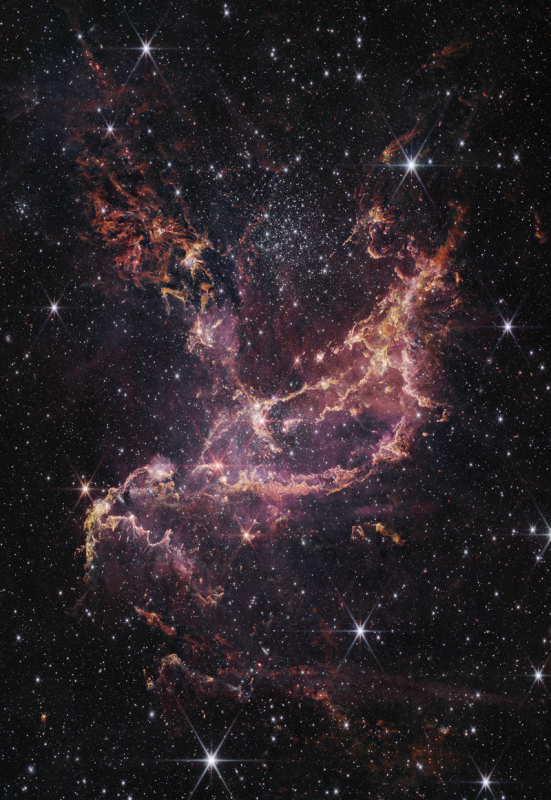
|
Credit & Copyright:
Science - NASA, ESA, CSA, Olivia C. Jones (UK ATC), Guido De Marchi (ESTEC), Margaret Meixner (USRA)
Processing - Alyssa Pagan (STScI), Nolan Habel (USRA), Laura Lenkid (USRA), Laurie E. U. Chu (NASA Ames)
Explanation:
The most massive young star cluster in the
Small Magellanic Cloud is NGC 346,
embedded in our small satellite galaxy's largest star forming region
some 210,000 light-years distant.
Of course the
massive stars of NGC 346 are short lived, but very
energetic.
Their winds and radiation
sculpt
the edges
of the region's dusty molecular cloud triggering star-formation within.
The star forming region also appears to
contain a large population of infant stars.
A mere 3 to 5 million years old and not yet
burning
hydrogen
in their cores, the
infant
stars
are strewn about the embedded star cluster.
This
spectacular infrared view
of NGC 346 is
from the James Webb Space Telescope's
NIRcam.
Emission from atomic hydrogen ionized by the massive stars' energetic
radiation as well as molecular hydrogen and dust
in the star-forming molecular cloud is detailed in pink and orange hues.
Webb's
sharp image
of the young star-forming region
spans 240 light-years at the distance of the Small Magellanic Cloud.
Science - NASA, ESA, CSA, Olivia C. Jones (UK ATC), Guido De Marchi (ESTEC), Margaret Meixner (USRA)
Processing - Alyssa Pagan (STScI), Nolan Habel (USRA), Laura Lenkid (USRA), Laurie E. U. Chu (NASA Ames)
|
January February March April May June July August September October November |
| ||||||||||||||||||||||||||||||||||||||||||||||||
NASA Web Site Statements, Warnings, and Disclaimers
NASA Official: Jay Norris. Specific rights apply.
A service of: LHEA at NASA / GSFC
& Michigan Tech. U.
Based on Astronomy Picture
Of the Day
Publications with keywords: NGC 346 - star cluster
Publications with words: NGC 346 - star cluster
See also:
